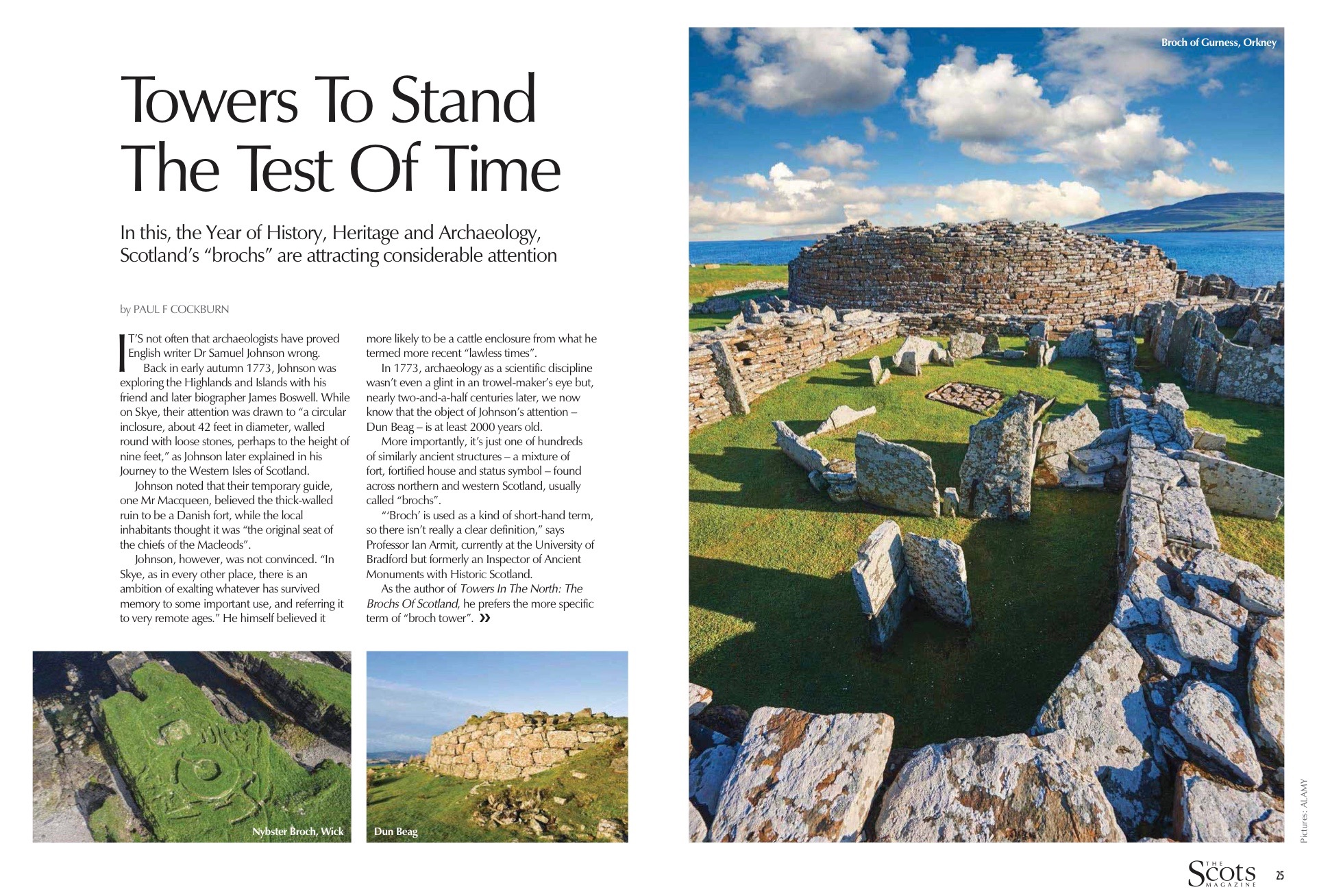
It’s not often that archaeologists have proved that proudly English writer Dr Samuel Johnson wrong.
Back in early autumn 1773, Johnson was exploring the Highlands and Islands with his friend and later biographer James Boswell. While on Skye, their attention was drawn to “a circular inclosure, about forty-two feet in diameter, walled round with loose stones, perhaps to the height of nine feet,” as Johnson later explained in his Journey to the Western Isles of Scotland.
Johnson noted that their temporary guide, one Mr Macqueen, believed the thick-walled ruin to be a Danish fort, while the local inhabitants thought it was “the original seat of the chiefs of the Macleods”. Johnson, however, was not convinced: “In Skye, as in every other place, there is an ambition of exalting whatever has survived memory to some important use, and referring it to very remote ages.” He himself believed it more likely to be a cattle enclosure from what he termed more recent “lawless times”.
In 1773, archaeology as a scientific discipline wasn’t even a glint in an trowel-maker’s eye but, nearly two-and-a-half centuries later, we now know that the object of Johnson’s attention—Dun Beag—is at least two thousand years old. More importantly, it’s just one of hundreds of similarly ancient structures—a mixture of fort, fortified house, and status symbol—found across northern and western Scotland, usually called “brochs”.
“‘Broch’ is used as a kind of short-hand term, so there isn’t really a clear definition,” says Professor Ian Armit, currently at the University of Bradford but formerly an Inspector of Ancient Monuments with Historic Scotland. As the author of Towers in the north: the brochs of Scotland, he prefers the more specific term of “broch tower”.
“Most of the classic brochs that we think of are broch towers; tower-like dry-stone round houses with a very specific set of architectural characteristics. Basically they’re built with a distinctive hollow walls construction technique so you’ve got these galleries between the two walls with stairs linking them.”
Dr Johnson may have been wrong in 1773, but even just 70 years ago archaeologists held different views to now. “Traditionally they were seen as being something very unusual and exotic,” says Ian. “The interpretation used to be that they were probably built by migrants fleeing from the Roman invasion in the south of Britain, because the only objects that were found in them that could be dated—before we had modern dating techniques—were Roman imports.”
The general consensus now, however, is very different, seeing the broch towers as basically a northern version of a well-established roundhouse-building tradition that covers the whole of the British Isles. “Basically, if you look anywhere from central England up to East Lothian or Angus or Aberdeenshire, in the Iron Age what you’re looking at are timber roundhouses—most of which are only known through the pits and the post holes which have been excavated. As you go into the Highlands, you’ve got roundhouses that were built of earth and stone; into the Highlands and Islands proper, the dry-stone (ie, cement-free) construction takes over.”
So who actually built the broch towers? “They are extremely accomplished structures and very complex to build, so they would’ve had to have been built by specialists,” says Ian. “It’s not that one person built all of them, but you would’ve had specialists—builders, architects—who must have travelled between communities. Probably most of the labour would have been supplied locally, but they would’ve had to bring in people to design and construct them.”
 BACK TO THE FUTURE
BACK TO THE FUTURE
Kenneth McElroy has long been interested in the past. “I grew up in Caithness and used to wander round the countryside, looking at historical sites and forcing my friends to come with me!” Yet it’s with his eyes very much on the future that he helps run the Caithness Broch Project. “The Dounreay nuclear power plant is going through a phase of decommissioning now,” he points out. “Caithness has to look elsewhere to encourage growth and to look after the future.”
Heritage tourism could well be one answer. “My colleague Iain MacLean had been travelling round the Orkney and Shetland Islands as a travelling salesman, and became aware of the vast wealth of archaeological sites that were in those areas,” Kenneth explains.
“Back in Caithness he thought that we could do with something like that; Caithness has just as many archaeological sites that are fascinating in their own right but have just never been promoted that much.”
The Project began with a simple Facebook page for people to discuss Caithness archaeology, and brochs in particular. “We soon realised that Caithness has more brochs than anywhere else, so we thought: Let’s promote this!”
The Caithness Broch Project is now an officially recognised charity with a range of projects and partners, and no one can accuse them of thinking small.
“Projects include community outreach work, such as the touring of a Lego Broch around local schools, in conjunction with local museum Caithness Horizons, and we will also be looking at other outreach activities, including talks, performers and demonstrations.”
They’re currently fund-raising for a Caithness Archaeology Festival—“Brochfest!”—while also looking into the consolidation and conservation of Ousdale, an existing broch in Caithness.
The ultimate aim—the hook—is the construction of a broch. “Undoubtedly that would give us an iconic, awesome heritage attraction—a living history experience through which you’ll be able to see, feel, smell the Iron Age.”
Its construction would also help archaeologists understand how brochs were constructed—what methods and tools were used, how long it would take, and how many men it would need. Assuming, of course, that some 2,500 years’ of health and safety legislation lets it happen. A proposed 1/15th scale model of the Project’s Broch, to be built by Dr Dimitris Theodossopoulos at the Edinburgh College of Art, may give the reassurance needed.
Outreach work remains vital, however. “We’ve no hope of inspiring tourists if we can’t inspire our own inhabitants; to promote the education, understanding and awareness of Caithness and its history to Caithness as much as the world.
“I’m pleased to say that some of my friends now know what a broch is,” he adds, “and that’s an achievement in itself!”
SIX OF THE BEST BROCH TOWERS
• Mousa Broch, Island of Mousa, Shetland.
The best preserved Broch Tower in Scotland? It’s been modified down the centuries, but a smaller diameter and thicker walls may help explain its survival.
• Broch of Gurness, Aikerness, Evie, Orkney
This broch stands at the centre of a well-preserved settlement of clustered stone houses that help give us a sense of the wider community.
• Dun Carloway, Western Lewis
Arguably the best preserved broch on Lewis, and in a stunning setting. A collapsed section of wall reveals a perfect cross-section of its construction.
• Nybster Broch, Wick, Caithness
Having been excavated on numerous occasions since the late 19th century, you can learn much about this particular broch in the nearby Caithness Broch Centre.
• Westerdale Brochs, Halkirk, Caithness
Along a three mile stretch of the River Thurso you can find remains of five brochs, two within a few hundred yards of each other!
First published by The Scots Magazine, #July 2017.